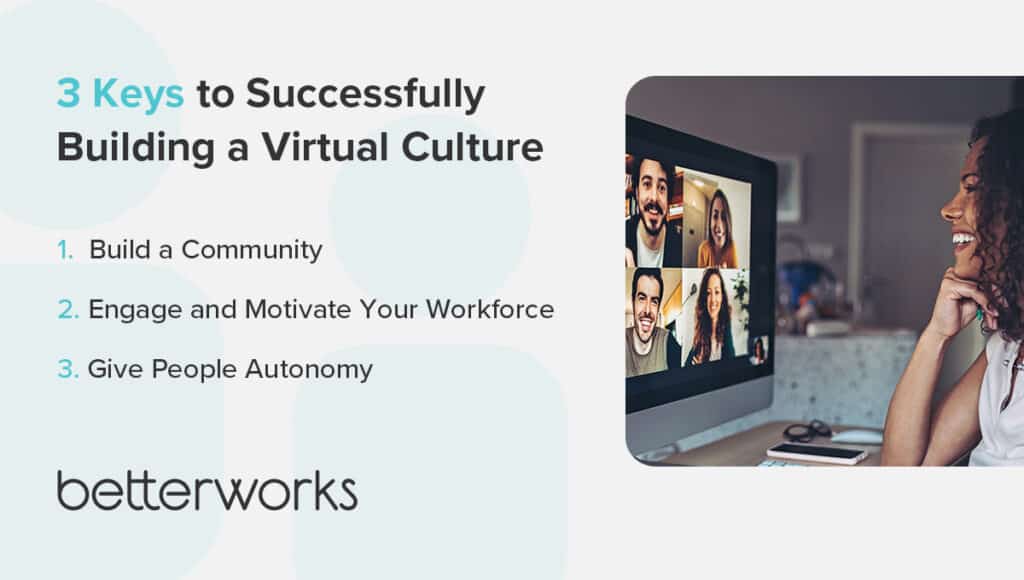Virtual leadership has become crucial to today’s business landscape. As the workplace becomes increasingly digital and distributed, the need for effective leaders who can manage a remote workforce has only increased. By understanding the unique challenges and opportunities of effective virtual leadership, businesses can become better equipped to lead their teams to success.
Explore the mindset of an effective virtual leader, the keys to a healthy remote culture, and ways to manage virtual teams effectively.
What is virtual leadership?
Virtual leadership is the art of leading a team of people when the leader and team members aren’t physically in the same location. This type of leadership requires excellent communication skills, the ability to build trust, and the charisma to motivate and inspire people without the benefit of in-person connection.
The best leadership styles for virtual leaders are participative and transformational. Participative leaders intentionally seek employee input and actively engage them in decision-making processes. Transformational leaders empower team members to take control of their work so they can contribute more effectively. Both leadership styles encourage participation and ownership, which are key to maintaining engagement and connection in a virtual environment.
In a distributed workplace, employees will interact with their direct manager most often and may never come into contact with managers above that level. Leaders further up the org chart have to lead by maintaining connections with employees and aligning their daily tasks with the company’s broader vision.

3 hallmarks of an effective virtual leader’s mindset
More businesses are moving toward a virtual environment, which means that leaders must learn to adapt their leadership mindset to fit this new setting. Learn which virtual leadership skills are most important and how to apply them.
Focusing on alignment and shared culture
Alignment is one of the most critical elements of virtual leadership. To align their teams, virtual leaders must be able to communicate the vision and goals of the organization and translate what that means for each person. They need to draw connections between team members’ daily tasks and individual goals and the larger business strategy.
It also falls to virtual leaders to make sure that everyone is on the same page regarding performance expectations. Successful remote workforce management relies on well-calibrated teams executing to the best of their abilities.
Another key element of successful virtual leadership is fostering a shared culture within the team. Leaders can do this by creating opportunities for team members to interact with each other on a personal level as well as by promoting a sense of camaraderie among team members.
Beyond the social aspects of culture, though, virtual leaders need to help employees stay grounded in the company’s values and oriented toward its vision. Frequent check-ins and conversation prompts help managers to keep these critical cultural elements at the forefront.

Embracing flexibility and adaptability
Flexibility is one of the top elements of an effective virtual leadership mindset. At the basic level, flexibility means giving team members the autonomy to work when, where, and how they work best. At a deeper level, though, flexibility is being open to new ideas and ways of doing things and being willing to change approaches when necessary.
Another key skill for virtual leaders is adaptability. In a virtual setting, things can change quickly, and unexpected challenges can arise. Leaders need to be able to adapt their plans and strategies on the fly to respond effectively. This requires the ability to think creatively and come up with solutions that may not have been considered before.

Leveraging technology to connect and collaborate
One of the biggest benefits of work technology is that it allows business leaders to connect and collaborate with people from all over the world. The best virtual leaders know how to use technology to enhance the human element of the work experience.
A virtual leader may implement rules around different digital communication channels, for example, so team members know exactly when and how to connect with colleagues based on their needs. Effective use of workplace tech is essential for collaborating in a virtual environment.
Great virtual leaders also know that, in our digital age, connection runs far deeper than communication among people. Seamless connections between tech systems are just as critical for enhancing employee performance. Integrating task completion data with goal alignment software, for example, can give virtual leaders an even better understanding of what’s going on in their teams than seeing people at work in the office would.

3 keys to successfully building a virtual culture
Culture is key to setting up a business for long-term success. But what happens when your team is spread out across the country or around the globe? How do you create a strong virtual culture that drives remote work engagement?
Explore these best practices to discover ways effective virtual leaders create thriving remote cultures.
Build a community
A strong virtual culture starts with a sense of community, but establishing that can be a challenge. After all, without face-to-face interaction, it can be harder to build rapport and trust, and easy for team members to feel isolated. It’s important to create an environment where employees feel connected to each other and invested in the company’s success.
Start by encouraging interaction and collaboration. Make it easy for employees to connect with each other and work together on projects. Use video conferencing tools, chat tools, and social media to facilitate communication and collaboration.
Be intentional about fostering a spirit of inclusion to ensure that everyone feels like they belong and that their voices are heard. Not everyone will be comfortable chiming in during an all-hands video call, for example. Asking for questions or input ahead of that call gives everyone a chance to share their perspectives.
Encourage employees to participate in companywide events and activities, even if they’re not located in the same office. Encouraging teams to bond over shared interests outside work also can help build stronger relationships.
Engage and motivate your workforce
It’s no secret that one of the key challenges of managing a virtual team is keeping employees engaged and motivated. Remote employees often work from home and may feel isolated from others, especially their colleagues. It’s up to HR leaders and team managers to create the spark of connection that ignites engagement.
One of the most important things managers can do is communicate regularly with their teams, both individually and as a group. This will help everyone stay on the same page, identify any issues early on, and feel connected to the rest of the team.
Make sure to schedule regular check-ins (weekly or biweekly at a minimum) and use video conferencing whenever possible so everyone can see each other’s faces. In between check-ins, stay in touch via email, instant messaging, or whatever communication platform works best for the team.
Another great way to keep remote workers engaged is to encourage collaboration and knowledge sharing. This can be done in a lot of ways, such as setting up regular “virtual coffee breaks” where team members can catch up with each other informally or holding regular brainstorming sessions where everyone has a chance to share ideas. Working together to achieve a shared goal forges very strong bonds, and it gives the team a reason to celebrate once they’ve met the goal.
You can also create opportunities for collaboration by using performance management tools that support real-time, two-way feedback so managers leading remotely can spot and address barriers to engagement before they become significant.
Finally, remember to reward good performance when you see it. This doesn’t just mean giving out formal promotions or raises (although those are important, too) but rather also taking the time to give public recognition for a job well done. A simple “thank you” goes a long way toward making someone feel appreciated, valued, and motivated to continue doing their best work.
Give people autonomy
Empowering employees to take ownership of their work is critical to creating a strong virtual culture. This means giving employees the autonomy to make decisions about their work, providing them with the resources they need to be successful, and trusting them to do their jobs well.
Virtual leaders can use goal alignment software to help people see exactly where they fit on the org chart and the business goals their team is responsible for accomplishing. Encouraging team members to think like business leaders gives them the autonomy to set their own goals that drive the business forward.
When employees feel empowered, they’re more likely to be engaged and invested in their work, which leads to better performance for the company.

Train managers to lead remote teams effectively
The greatest responsibilities for daily virtual leadership fall to direct managers. As HR leaders, one of your greatest priorities is making sure that managers have the resources, skills, and confidence to effectively lead remote teams.
Explore some of the greatest challenges virtual leaders face and how you can prepare managers to overcome them.
Losing the message in translation
In virtual work environments, it may be more difficult to pick up on nuanced communication, such as the nonverbal cues and understood cultural norms that direct behaviors. It’s easy for meaning to be lost or distorted in a virtual setting.
To overcome that challenge, train managers to communicate with intention. It’s better to overcommunicate than to leave too much to interpretation. Managers need to ensure that everyone on the team is on the same page and that everyone knows what’s expected of them.
As part of your management training program, offer modules on workplace communication. Encourage managers to apply what they learn to actual conversations with their peers and team members to strengthen their communication skills.
Slipping into micromanagement
For decades, managers have physically overseen their team at work, but we no longer have those visual cues to tell us that work is happening. That can lead remote managers to focus on the wrong priorities and become too involved in telling people how to get their work done.
People leading virtual teams need to find the right balance between authority and autonomy. Virtual leaders need to have a clear vision for what needs to be accomplished and be able to communicate that to team members as their priorities — and then step back and let them work.
Train managers to focus on outcomes rather than when, where, or how team members get their work done. Effective virtual leaders manage each team member’s workload and set clear timelines for deliverables so they know what they need to do and when they need to have it ready to go.
Remind managers that failure is an important learning tool. Encourage them to delegate low-risk tasks to team members to give them opportunities to learn without feeling too much pressure to execute perfectly.
Losing sight of people on the other side of the screen
When we don’t interact with people in a physical setting every day, it’s harder to remember that there are whole people on the other side of the screen. Virtual leaders need to build relationships with their team members — and they don’t have to see each other in person every day to make that happen.
As part of the performance management process, prompt managers to set up regular check-ins via video conferencing with each of their team members. Remind them that it’s OK to show interest in team members’ lives outside work.
Most importantly, encourage managers to ask how their team members are doing as people, not just as employees. The better a manager knows their team, the easier it becomes to spot when something’s wrong. That helps team leaders head off problems before they become a big concern.
Strong relationships between managers and team members also help leaders gain a better sense of each person’s strengths and interests so they can help them find their ideal place in the organization. Develop conversation prompts to help managers explore each person’s interests and career aspirations.

Virtual leaders are the future of business
Virtual leaders and managers are essential to the success of businesses in today’s digital age. They provide an efficient and effective way to manage teams, projects, and processes without needing to be physically present. Virtual leaders can leverage technology to build trust and collaboration with their teams while also allowing for greater flexibility and creativity.
Despite the challenges posed by leading in a virtual environment, the advantages far outweigh the drawbacks. With the right support, virtual leaders can succeed in building thriving teams and organizations that are positioned to compete and succeed in the digital age.
Want to learn more? Find out why virtual leadership is important.


